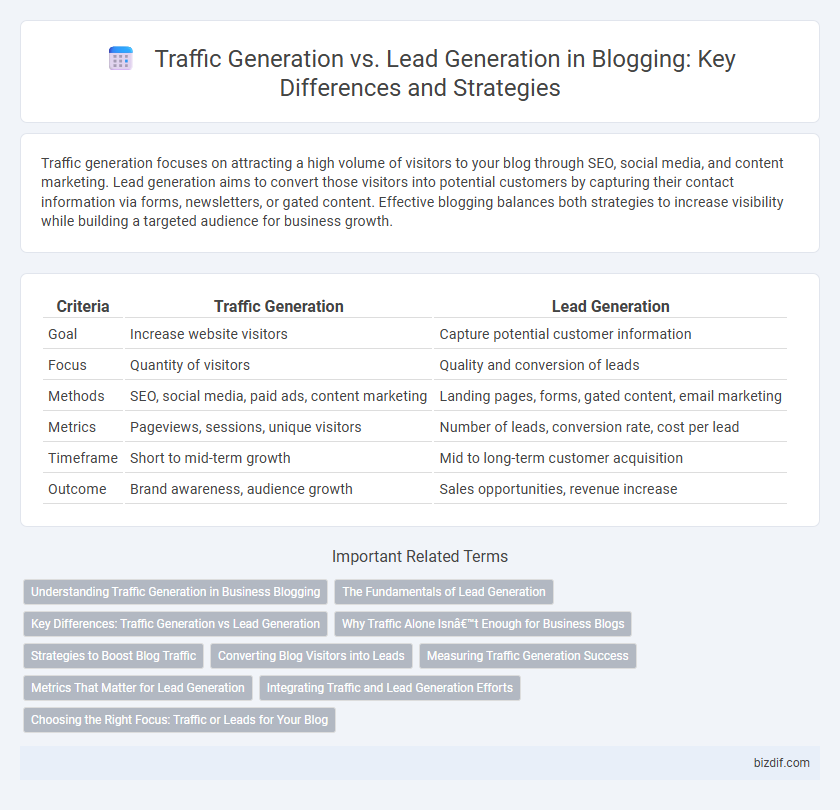Traffic generation focuses on attracting a high volume of visitors to your blog through SEO, social media, and content marketing. Lead generation aims to convert those visitors into potential customers by capturing their contact information via forms, newsletters, or gated content. Effective blogging balances both strategies to increase visibility while building a targeted audience for business growth.
Table of Comparison
| Criteria | Traffic Generation | Lead Generation |
|---|---|---|
| Goal | Increase website visitors | Capture potential customer information |
| Focus | Quantity of visitors | Quality and conversion of leads |
| Methods | SEO, social media, paid ads, content marketing | Landing pages, forms, gated content, email marketing |
| Metrics | Pageviews, sessions, unique visitors | Number of leads, conversion rate, cost per lead |
| Timeframe | Short to mid-term growth | Mid to long-term customer acquisition |
| Outcome | Brand awareness, audience growth | Sales opportunities, revenue increase |
Understanding Traffic Generation in Business Blogging
Traffic generation in business blogging focuses on attracting a high volume of visitors to a website through targeted content, SEO strategies, and social media engagement. Effective traffic generation increases brand visibility and provides opportunities for user interaction, which can be converted into leads over time. Measuring traffic sources and user behavior helps refine content strategies and optimize marketing efforts for sustained audience growth.
The Fundamentals of Lead Generation
Lead generation fundamentally involves capturing potential customer information through targeted content, calls-to-action, and optimized landing pages to nurture prospects into sales-ready leads. Unlike traffic generation, which aims to increase the volume of visitors to a blog, lead generation prioritizes quality by focusing on engagement metrics such as email sign-ups, form completions, and lead magnet downloads. Effective lead generation strategies rely on data-driven segmentation and personalized follow-ups to convert blog traffic into long-term business opportunities.
Key Differences: Traffic Generation vs Lead Generation
Traffic generation focuses on attracting a high volume of visitors to a blog through SEO, social media, and paid ads, aiming to increase overall visibility. Lead generation prioritizes capturing visitor information through forms, newsletters, or gated content to convert traffic into potential customers or clients. Key differences include traffic generation measuring success by visitor numbers, while lead generation emphasizes qualified prospects and conversion rates.
Why Traffic Alone Isn’t Enough for Business Blogs
High blog traffic indicates visibility but doesn't guarantee customer engagement or conversions essential for business growth. Effective lead generation captures visitor information, transforming casual readers into potential clients and nurturing long-term relationships. Prioritizing lead generation strategies like targeted calls-to-action and subscription forms maximizes the blog's return on investment beyond just attracting visitors.
Strategies to Boost Blog Traffic
Effective strategies to boost blog traffic include leveraging SEO techniques such as keyword optimization, creating high-quality, shareable content, and utilizing social media platforms to increase visibility. Incorporating guest blogging and backlink building improves domain authority, driving more organic visitors to the site. Consistent analysis of traffic metrics and audience behavior enables fine-tuning of content strategies to maximize reach and engagement.
Converting Blog Visitors into Leads
Effective blog traffic generation attracts a high volume of visitors through SEO, social media, and content marketing strategies. Lead generation focuses on converting these visitors into actionable leads using targeted calls-to-action, compelling lead magnets, and optimized landing pages. Prioritizing conversion rate optimization and personalized user experiences significantly increases the number of qualified leads from blog traffic.
Measuring Traffic Generation Success
Measuring traffic generation success relies on analyzing key metrics such as unique visitors, page views, and bounce rates to assess the volume and quality of blog audience engagement. Tools like Google Analytics provide detailed insights into user behavior, referral sources, and session duration, enabling precise tracking of content performance. High traffic with low bounce rates and longer session durations indicates effective traffic generation strategies that attract and retain targeted visitors.
Metrics That Matter for Lead Generation
Metrics that matter for lead generation focus on conversion rates, cost per lead (CPL), and lead quality rather than just overall traffic volume. Tracking engagement indicators such as time on page, click-through rates on call-to-action buttons, and form submission rates provides deeper insights into lead generation effectiveness. Prioritizing qualified lead acquisition and measuring return on investment (ROI) from lead nurturing campaigns drives better business growth compared to solely increasing website visits.
Integrating Traffic and Lead Generation Efforts
Integrating traffic generation and lead generation efforts maximizes the effectiveness of a blog by driving targeted visitors who are more likely to convert. Utilizing SEO strategies, content marketing, and social media campaigns attracts high-quality traffic while embedding clear calls-to-action and lead capture forms converts that traffic into valuable leads. Tracking user behavior and optimizing the conversion funnel ensures continuous improvement in both traffic volume and lead quality.
Choosing the Right Focus: Traffic or Leads for Your Blog
Choosing between traffic generation and lead generation depends on your blog's goals: traffic boosts visibility and audience growth, while leads prioritize converting visitors into potential customers or subscribers. Analyzing metrics such as page views, bounce rate, and conversion rates helps determine which focus aligns with your business objectives. Optimizing content for SEO enhances traffic, whereas targeted calls-to-action and lead magnets improve lead capture efficiency.
Traffic Generation vs Lead Generation Infographic

 bizdif.com
bizdif.com